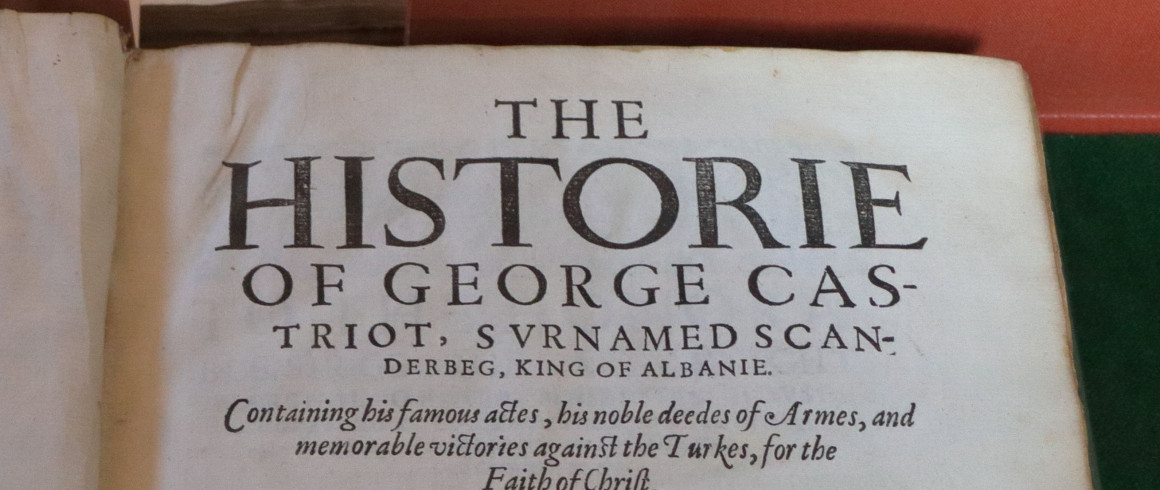The Anglo-Albanian Association with the Scanderbeg Symposium
Today, 28 November, is Albania’s national day, commemorating the country’s independence from the Ottoman empire in 1912. It’s a particularly relevant day to talk about a symposium held by the Anglo-Albanian Association on 22 November in the Old Library at Pembroke on Scanderbeg, Albania’s national hero.
The symposium included an exhibition of antiquarian books from Patricia Nugee’s unique collection of sixteenth-, seventeenth- and eighteenth-century books on Scanderbeg, and explored Scanderbeg’s place in European history and literature.
Gjergi Kastrioti Skanderbeu (1405-1468), was called Iskender Bey by the Ottomans (later westernised as Scanderbeg, meaning ‘Lord Alexander’) in reference to his military abilities which the Turks thought reminiscent of Alexander the Great. Between 1443 and his death in 1468 he was celebrated for leading a series of highly successful campaigns against superior Ottoman forces. Albania’s independence day is known as Dita e Flamurit (Day of the Flag) because the flag of Albania is derived from Scanderbeg’s personal arms.
Books, poems, plays and operas about Scanderbeg began appearing early in the 16th century. The first book, published in Rome c.1510, was Marinus Barletius’ Historia de vita et gestis Scanderbegi, Epirotarum Principis (History of the Life and Deeds of Scanderbeg, Prince of Epirus). Translations appeared in French, English, German, Swedish, Portuguese and Spanish in the following years, many of which were on display during the symposium. Pembroke alumnus Edmund Spenser wrote a sonnet in praise of him in 1596. Three plays featuring him were performed on the London stage in the mid eighteenth-century.
Lord Chris Smith opened the event and Stephen Nash, Pembroke alumnus and ambassador to Albania 1998-1999, introduced the speakers. Miss Patricia Nugee gave an introduction to the history of her unique book collection.
David Abulafia, Professor of Mediterranean History at Cambridge University, Papathomas Professorial Fellow of Gonville and Caius College, and author of The Great Sea: A Human History of the Mediterranean spoke on ‘The era of Scanderbeg’.
Vito Bianchi, professor at Università degli Studi, Bari, and author of Otranto 1480: Il sultano, la strage, la conquista, (Editori Laterza, Roma-Bari 2016), spoke on ‘After Scanderbeg: the Ottomans between Albania and Italy’.
Dr Louise Marshall’s paper was entitled Three eighteenth-century plays about Scanderbeg: whose story are they telling? She lectures in Restoration and Eighteenth-Century literature at Aberystwyth University, and is the author of National Myth and Imperial Fantasy: Representations of Britishness on the Early Eighteenth-Century Stage (Palgrave, 2008).
The Anglo-Albanian Association was founded in 1912 with the aim of championing Albania’s independence, and has evolved since. Today they organise events such as guest lectures on Albanian history, culture and music, book launches and screenings of films. You can find more information on their website.
A co-founder and early supporter, both as Treasurer and Joint Honorary Secretary was Edith Durham, who was a foreign correspondent, traveller, artist, photographer and anthropologist of the Balkans. At the symposium her great-nephew, Pembroke Fellow Dr James Hickson, displayed her Insignia of Grand Officer of the Order of Skanderbeg (1930).
[auto-gallery]














[/auto-gallery]
Some more history:
In March 1444, a council of Albanian and Serbian princes and tribal chiefs was held at Lezhë in northern Albania at which Scanderbeg was elected principal leader and commander-in-chief of some 8,000 warriors. Later that year, in November, following the defeat of the Slavic army led by Vladislav IV of Poland and Hungary and his chief commander János Hunyadi at the Battle of Varna, Scanderbeg used the ensuing chaos to lead a revolt against the Ottomans from his stronghold of Kruja which he had held as a vassal of the Sultan since 1438.
Appointed Captain-General of the Christian armies in the Balkans by Alfonso V of Aragon, Scanderbeg became synonymous with the leadership of the Albanian people and, despite the fall of Constantinople to the Turks in 1453, carried out a sustained and highly successful resistance against the Ottomans until his death in 1468. Worn out by his military exertions and illness his death signalled the time for revived campaigns by superior Turkish forces. During the last twenty years of the fifteenth century Christian principalities and statelets of the Balkans and the Italian peninsula bore the brunt of three successive Ottoman Sultans’ expansionist policies, notable among which were the Ottoman fleet’s invasion of Otranto in southern Italy in 1480 and the fall of Durres in 1501 after which all of Albania was incorporated within the Ottoman Empire.
Scanderbeg was again commemorated when the country declared its independence from the Ottoman Empire in 1912 – an event celebrated by Albanians everywhere on 28th November each year as Dita e Flamurit or ‘Day of the Flag’ because the flag of Albania is derived from the personal arms borne by Scanderbeg during his campaigns. In 1968 the communist Hoxha regime erected the famous equestrian statue of Scanderbeg in the main square of Tirana, and in 1982 a museum was established in his restored mountain stronghold of Kruja some 20Km north of Tirana.
